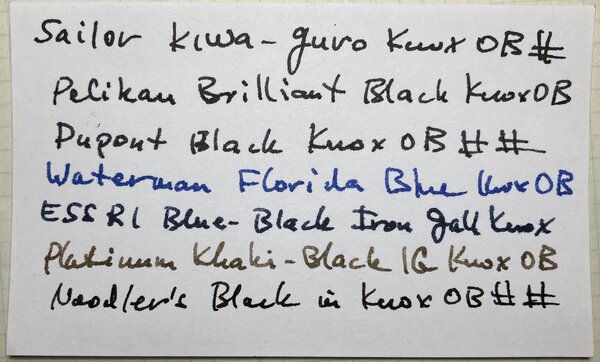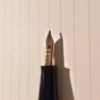Search the Community
Showing results for tags 'feathering'.
-
Are there any additive that could be added to an existing ink to make it feather less, beyond the usual thickeners, such as gum arabic? Has anyone measured their effects? Are any preferred for low pH, high pH inks? [According to the article referenced here, it was found that ink actually performs better without gum arabic, but only after it had been accidentally left out from the official government recipe.] @InesFposted an extremely detailed analysis of ink spreading and a theory on ink wetting. Some of the results are: Unfortunately the surface tension can't be increased easily (some salts increase surface tension marginally, but only in very high concentrations). I found one interesting patent that uses a different approach: To reduce the flow (wetness?), they increase the wetting angle of the ink/nib interface. This is done by adding a flotation agent, which also happens to reduce the surface tension. Feathering is then independently controlled by adding a colloid. https://patents.google.com/patent/US1932248A/en This is a highly alkaline ink, maybe the vintage Superchrome ink used similar ideas. The ink is made alkaline to quickly sink into the paper, but this leads to undesirable effects: They say that surface tension doesn't matter, but what matters is the wetting angle on the nib. To keep the ink from wetting the nib, they add amyl xanthate. Xanthates do lower the surface tension, see also Fig. 2 of https://pubs.acs.org/doi/pdf/10.1021/ja01308a003#, but increase the wetting angle on the nib: They name a couple of alternative substances to increase the wetting angle: The ink will still feather, which is fixed by adding starch Finally, they add bentonite clay to improve the flow. I have no idea why this works.
-
Scientific American Article From 1959, On Ink-Nib-Paper Relationship
TenBladeSummitar posted a topic in Th-INKing Outside the Bottle
An interesting article from Scientific American New Scientist (edited - thanks to those who pointed out the error), 1959, outlining the history of the development of quick-drying fountain pen ink, and how the ink and paper interact to influence perceived feathering or line spread. It also is clear how ink recipes can affect pen components or reliability thereof. http://bit.ly/Science_of_Quick_Drying_Fountain_Pen_Inks- 15 replies
-
- ink
- quick drying ink
-
(and 8 more)
Tagged with:
-

Sandy1 review of Parker Penman Sapphire - close-up to show shading and feathering on Clairefontaine Triomphe paper.webp
Mercian posted a gallery image in FPN Image Albums
From the album: Sandy1
This image is the close-up that is intended to show shading and feathering on Sandy1’s review of PPS. It is a close-up of her writing with PPS on Clairefontaine Triomphe paper. It is the image from the sixth link from the top of the page - the image that used to reside behind the fifth link is currently inaccessible.
- 0 B
- x
-
- sandy1
- parker penman sapphire
- (and 4 more)
-
desaturated.thumb.gif.5cb70ef1e977aa313d11eea3616aba7d.gif)
MEMMO FP Soft Touch Cover A5 Notebook
A Smug Dill posted a topic in Paper & Pen Paraphernalia Reviews and Articles
(Originally posted over here.) I was killing time in Kinokuniya last week, and came across a big pile of A5 notebooks priced at A$4.95 each. That's atypically low for paper products that Kinokuniya chooses to carry, to put it mildly; and these notebooks are not exactly thin, have covers of some material that is seems stiffer and more ‘premium’ than (kraft or other) paper or card, and weren't marked as clearance stock or otherwise discounted that I could see. Every book is sealed in a clear cellophane pocket with a resealable flap; and, being Kinokuniya, its staff were sure to additionally tape the flap down over the store's price sticker, which in turn sits on top of and obscures the human-readable information on the manufacturer's barcode sticker. On only some of the notebooks, which come in three different colourways, there are see-through stickers that describe the product features less-than-comprehensively thus: Notebook 8 page index numbered pages 100gsm acid free paper fountain pen fantastic soft touch cover Lined without disclosing the actual page count, how far apart the ruled lines are, or where the product (or paper) was made. The brand is MEMMO, which I have never heard of until then. Between the incredibly low price and the claim of being “fountain pen fantastic”, I just could not contain my curiosity; and so I took one unit to the counter in the stationery department and asked for more information. The lady there didn't know; and so she offered to open one up to show me, which necessitated cutting the pocket along a seam with a knife, given the additional measures to ensure customers cannot easily unseal the retail packaging themselves (in-store or at home). Each book has 150 numbered pages, and additionally 8 index pages titled Index 2017. (I have now looked inside all three colourways, and they are all stuck equally far in the past) Upon my drawing her attention to it, the lady remarked, “No wonder they're cheap.” The horizontal guidelines on regular pages are ruled 6mm apart; and there is space marked out, with virgules as field separators but no year number preprinted, in the outside-edge corner at the top for the date; so the format is perfectly usable with no distracting outdated markings. The paper itself does not look or feel coated, and the cover material is somewhat rubbery to the touch and stiffer than, say, a latex oven mitt. All nice enough features to raise its standing above the average notebook one'd find in the MUJI store downstairs or Officeworks across the road. The Internet domain name (which is not exactly a ‘web page’ or URL), memmo.com.au, printed on the top sheet alludes to the brand being Australian, but I cannot find any explicit statement of where the product was made or from where the paper was sourced. All the same, it all seems too good to be true, so I just had to risk $5 (but be also mentally prepared to return to the store and buy $100 ‘worth’ of the remaining stock). Well, it is too good to be true. The paper is not bad, but (very loosely speaking) there is visible bleed-through to the other side of the 100gsm sheet from eight or nine out of every ten inks I have tested, although not to the extent of being greatly distracting if there is handwritten text in front of the spots of ink bleed. There is also noticeable, albeit sparse, feathering with maybe half of the inks; and, by that, I mean ink travelling in awkward directions along fibres on the paper surface away from the ink marks, not woolly outlines. Lines of ink tend to spread more than on Rhodia, but may be on par with the recto side of Exacompta FAF 70g/m² paper. If I'm to keep a journal or subject-specific notebook, in which I would typically write with several, or even many, different pens and different inks, I probably won't enjoy writing in this type of notebook, or subsequently rereading what I'd written. In terms of paper quality, I'd say it's on par with the 100gsm paper used in Paperblanks Flexis softcover journals. The Flexis paper is more apt to exhibit bleed-through, but more resistant to feathering; and it's off-white in colour, whereas the paper in this 2017 notebook is a cool white in spite of the coloured edges on three sides. I've subsequently found that the aforementioned domain name, when used as a partial URL (absent the https:// protocol part), does not bring up a website of the same name; it redirects to the website of a different brand/company, although that company seems to sell some similar products (priced at A$19.95 each) of which the description does not match the details of this notebook exactly. The website claims it is “fountain pen friendly” (as opposed to “fountain pen fantastic”). I'm not going to order one at that price to see if it uses the same paper, or is in fact the same product; but for now I strongly suspect it is the case, and just that the details listed are inaccurate in more ways than one and cannot be trusted. So, being a sad, pathetic stationery junkie, what did I do mid-week? Return to Kinokuniya and buy another, of course, since the first book has been ‘ruined’ with my testing so far. I won't use it for journalling — and I already have many dozen new Paperblanks and (better than that) Peter Pauper Press journals here anyway — but there is probably one particular application for which this MEMMO FP paper is suitable, in spite (or specifically because) of its minor flaws: an inking log book. I'm not going to see which inks are more likely to produce feathering and bleed-through, if I keep using Apica notebooks or switch to Clairefontaine ‘Age Bag’ notebooks for my inking log book. On the other hand, keeping an inking log book on this flawed paper would not only tell me the colour of the ink, but also warn me which inks could spell trouble on inferior paper.- 6 replies
-
- memmo fp
- soft touch cover
- (and 8 more)
-
-
desaturated.thumb.gif.5cb70ef1e977aa313d11eea3616aba7d.gif)
MEMMO FP A5 notebook in so-called blue - product page vs actual item
A Smug Dill posted a gallery image in FPN Image Albums
-
desaturated.thumb.gif.5cb70ef1e977aa313d11eea3616aba7d.gif)
MEMMO FP A5 notebook in black-purple - product page vs actual item
A Smug Dill posted a gallery image in FPN Image Albums
-
desaturated.thumb.gif.5cb70ef1e977aa313d11eea3616aba7d.gif)
Overview of 4 pages of writing samples on MEMMO FP (Blue tester) notebook
A Smug Dill posted a gallery image in FPN Image Albums
-
- memmo fp
- soft touch cover
- (and 8 more)
-
desaturated.thumb.gif.5cb70ef1e977aa313d11eea3616aba7d.gif)
MEMMO FP (Blue tester) notebook feathering collage (300dpi)
A Smug Dill posted a gallery image in FPN Image Albums
-
- memmo fp
- soft touch cover
- (and 7 more)
-
-
- memmo fp
- soft touch cover
- (and 8 more)
-
-
- memmo fp
- soft touch cover
- (and 8 more)
-
-
- memmo fp
- soft touch cover
- (and 8 more)
-
-
Hello All, I am an experienced fountain pen user whose collection of nibs is flexier/wider/stubbier than average. After a lot of research I have some paper materials for personal correspondence that suit almost all my pens and inks. However, I write a lot of preprinted "get-out-the-vote" postcards on card stock from varied sources. Feathering is driving me crazy. So I'm asking your help to identify inks that perform better than average holding their line. I already have Noodler's X-Feather Black and X-Feather Blue. After writing this I plan to ask in Reddit's pen/ink trading forum for anyone willing to trade/sell their X-Feather Red or Brown. (Who would ever do that?) But the Blue and Black still feather on lots of postcard papers I have... so not a panacea. I already have Pelikan 4001 Brilliant Black, 4001 Brown, and 4001 Turquoise for my oldest pens. These, too, usually feather. Kon-Peki feathers a lot. Diamine Royal Blue one of the worst, but the UK company's Red Dragon is better than most. I am hoping there are "sleeper" low-feather inks your experience suggests that I sample. For postcarding I researched various ways of getting card stock. Even my most consistent supplier sends problematic stock at times. This is not the usual "copy-paper-feather" problem - It's smooth card stock: I've discussed it with Tech Support personnel at the big five paper companies in North America - there are such people - to discover card stock surfaces on paper nowadays distributed to big printers and paper merchants lacks a kind of pen-friendly sizing that used to be common in that paper business. So it's a 1. low demand and 2. supply-chain performance fail. Paper makers are canceling "product lines" that had the requisite sizing for fountain pens and other specialty printing inks. Crane's, for example, a well-known personal correspondence fine papers manufacturer, admits in their Tech Support department that they now have NO fountain-pen-friendly paper in their line. Crane's has been a solid USA personal stationery supplier for 221 years, and still makes the paper on which USA currency is printed. But my grandmother would be amazed there is no paper for her letters were she still here to write them. I am aware I cause some of the problem with wet, wide-line pens. But even with this character flaw <grin> I deserve to have fun while I write easy-to-read lines. Thoughts, FPN people? Thanks, in advance, jonathan7007
-
-
I have seen attendees at recent pen shows mention new [Noodler's]x-feather colors. Has anyone seen these at a retailer, or know anything about their release into the market? I use the black every day due to my paper and nib choices. Really want to have options.
-

Pre-Treatment Of Paper To Reduce Porosity
Gutbucketeer posted a topic in Paper and Pen Paraphernalia
So I have like four dot grid notebooks that were gifts because people knew I liked pens and use dot grid notebooks. The problem I'm having is that they bleed and feather when I use anything other than a fine or extra-fine nib, or a wet ink. I would like to find someway to use them, until I can get a fountain pen friendly B5 notebook for my daily notes. There has been significant discussion on using art fixatives to preserve notes, addresses, drawings, etc. AFTER they have been created, but I can't find anything regarding reducing the porosity and absorbency of "cheap paper" to make it fountain pen friendly. Does anyone have solutions or hacks for this, or is it simply buying quality (and expensive) papers. I am going to do a test with my wife's hair spray lightly sprayed on a sheet then quickly wiped down. Thoughts and suggestions appreciated. Jim Bunch- 9 replies
-
- paper
- feathering
-
(and 2 more)
Tagged with:
-
Okay so I know this sounds strange (or normal for those who have been in the hobby for long enough), but I've received a lot of information regarding pigmented inks which have ended up being quite confusing. The main source of confusion is in its behaviour on paper. I've seen glowing reviews of inks such as Sailor nano inks, Montblanc Permanent Inks and Platinum Carbon ink, but then I've got some more confusing (not contradictory) information regarding the pigmented inks from Rohrer & Klingner regarding their behaviour on paper: bleeding and feathering (at least with flex)? little bleeding and feathering? There is also confusion coming from my own experience: Speedball India ink (don't worry, I used it with a dip pen, no fountain pens were used) spread everywhere, feathered, and bled quite a bit, even on high quality paper such as Clairfontaine, and even cartridge paper. I could only be *salvaged* when I went to dilute it, and only ended up behaving when I had made it a 6:1 water:ink solution, producing a very sad, light grey. Rohrer & Klingner Sepia Calligraphy ink ended up misbehaving too, though it was slightly better than the Speedball. May I please get some clarification on why this is?
- 6 replies
-
- feathering
- bleeding
-
(and 3 more)
Tagged with:
-
Which fountain pen inks would you use to test an unfamiliar paper product for (at least some aspects of) its fountain pen friendliness? Recently I've been in a frenzy of acquiring more notepads and notebooks, on which to write with fountain inks, largely in brick-and-mortar stores with Japanese names such as Daiso, Muji and Kinokuniya. Unfortunately, it is not common practice for stores here to have samples or tester units of paper products; Daiso has none, and Muji may put out just one or two but not selected on the basis of either, "compare our premium made-in-Japan writing paper, against our 'planting tree' line sourced primarily from Indonesia, and our recycled paper line with a minimum of 55% recycled content made in either country," or, "we say this line of notebooks is show-through resistant, so have a go writing or drawing on it with your pens of choice!" Kinokuniya offers a few, but far from covering all the main brands of which it sells multiple product lines; the samples are mostly $20+ notepads and $25+ journals. Nevertheless, Daiso products on a per-item (but not necessarily per-page) basis, are cheap enough to be perhaps 'worth' just buying one as a private tester unit, if upon inspection in-store the paper seems promising; the same can be said of (only) some Muji products. Not so what Kinokuniya sells! Anyway, I'm of a mind to put together a handful of (no more than five or six) fountain pens in a carry case, as the essential test kit for writing paper, whether I do the testing on provided tester units in-store, or what I actually purchased on a punt. Obviously, the selection of pens and inks would reflect my personal writing habits and preferences, but as a limited test kit and of course limited time in which to do such testing I'm primarily interested in covering edge cases while still being 'reasonable'. (For example, as far as I'm concerned, using Noodler's Polar Green ink would be unreasonable; in my experience it feathers on and bleeds through just about every make and type of paper, so much so I had to stop using it for anything and give my bottles of it away in spite of having bought them for its purported 'bulletproof' qualities.) Here's an example of the kind of testing I have in mind: Muji 裏うつりしにくいノート B5 Notebook Set Now, I'm curious as to what you — and everyone else — would choose for testing. I hate feeling as if I have to pre-empt this, but I want to make this clear: the question is not, "What would you like to see in a paper review prepared by someone else at their expense?" I want to know what's relevant and important enough to you that you would spend the money, take risks, and/or make the effort to buy, sample and test unfamiliar paper products for their suitability for your usage with fountain pens; what enthuses you enough that, pass or fail, you'll want to share the results at your cost with other hobbyists. I'm thinking in terms of us as doers and contributors to the community, not merely takers and consumers of crowd-sourced information or frugal shoppers. I'm still refining my own list, but roughly in order of priority: Platinum Carbon Black — I love pigment inks for their permanence and waterproofness, including not changing colour when soaked or washed, when it comes to content that I want to remain legible for the lifetime of the paper (and perhaps my lifetime); and I'd want a dense, dark, 'formal' colour for testing. Sadly, Sailor kiwaguro is not waterproof, and so I prefer Platinum Carbon Black, but I do find that some papers don't take well to the latter. All the better to include that as the Number One ink in my test kit. Interestingly, problems with feathering and bleed-through of this ink are more likely to manifest with high stroke density using a very narrow nib, as opposed to writing with a broad or stub nib, so for the purposes of the test kit, the ink will be dispensed using a Japanese Fine or Extra Fine nib.Platinum Classic Ink Lavender Black — I think a paper product should be tested for how it deals with iron-gall inks, and of the three iron-gall inks I have today (but two more are on order), I like the colour and punchiness of Lavender Black the best, when delivered using a Stub nib. Not just writing with a broad nib for "showing off" the ink, but to render some semblance of Italic writing on paper; the shading is a not-unwelcome side effect, but the base colour (which would get ruined by soaking or washing) and water resistance is the reason I use this ink.Pelikan 4001 Blue/Black — This is just a very old bottle of presumably iron-gall ink I have, which is what I use with the pen that has my favourite nib, a 14K gold Pelikan EF nib that Dan Smith customised to a crisp italic for me. For the purposes of testing a paper product, I'd be primarily looking at the crispness of the pen strokes on the page.Sailor Shikiori yodaki — I love the colour but hate the wetness of this ink, and it's a relatively expensive ink to boot (as it was never offered in the round 50ml Sailor Jentle bottles the way the sixteen originally Shikisai colours were). Oh, and it sheens green and gold. In my experience, many coated and uncoated papers don't deal well with a wet line of this ink.Diamine Iridescink Robert — A highly saturated monster-sheener of an ink, that is much cheaper than Sailor Shikiori yodaki and of which I have a large bottle. At the moment I primarily use it in a Pilot Elabo with a Soft Extra Fine nib, and many papers have problems with bleed-through when I allow the nib to linger for a moment as I try to flex the nib to get swells in pen strokes.I haven't quite decided what the sixth ink should be; Noodler's Air-Corp Blue-Black is a candidate, and so is Diamine Jalur Gemilang. I use Sailor souboku and seiboku pigment inks in Fine-nibbed pens often, but they tend to be so well-behaved on most papers that they don't warrant testing when I'm unsure of a new or unfamiliar paper product. Over to you! Edit: Eleven new inks just arrived in the past 24 hours, so I may have to look at revising my list.
- 27 replies
-
Hi, I love drawing on newsprint paper which feathers and soaks up ink in glorious globs whenever I stop moving the pen for an instant. But of course newsprint is not archival and turns yellow. Is there an acid free newsprint-like paper? I've looked but have not found such a thing. Any help appreciated. Thanks.
- 13 replies
-
desaturated.thumb.gif.5cb70ef1e977aa313d11eea3616aba7d.gif)
Daiso Rakugaki A5 Sketch Pad
A Smug Dill posted a topic in Paper & Pen Paraphernalia Reviews and Articles
I picked up a Daiso Rakugaki A5 Sketch Pad while I was in the store yesterday. I'd strongly advise not writing on the pages of one with a fountain pen.-
- daiso
- sketch pad
-
(and 3 more)
Tagged with:
-
Afternoon All, Wondering if someone could impart some friendly advice on me. I have used Black n' Red's wire booked A4 90gsm "Optik Paper" for the last 5-6 years for my day to day notes / scribbles at work etc. I probably go through a 140 page notebook every 2 months so I have quite a few of them collected on my bookshelf now. Sadly it appears that they have recently changed the manufacturing process / paper finish as on my latest notebook from my recent re-stocking of new notebooks, I am getting pretty annoying feathering for the first time ever. The paper looks and feels different, but Black n' Red have this down as the "same" notepad. I am using the Platinum Mixable Inks as there is a particular shade of blue I have become fond of which I mix myself, which is the blue colour in the photo. (For anyone interested it is 3 parts Aurora Blue (AB), 3 parts Aqua Blue(QB) and 1 part Silky Purple (SP).) I have never had this problem on this notepad prior to the change but its incredibly annoying now especially as I keep all my filled in notebooks. Would someone be able to give a bit of advice if there is anything I can do to the ink to "dry" it out a bit or if anyone could recommend a good notebook that I can use moving forward which has good quality paper as well as a cover finish (Hard back cover and wire bound). Cheers Mike
-
desaturated.thumb.gif.5cb70ef1e977aa313d11eea3616aba7d.gif)
A Paper That Makes Noodler's X-Feather Ink Exhibit Feathering
A Smug Dill posted a topic in Paper and Pen Paraphernalia
(The topic title notwithstanding, this is not really about the paper, but the inks in question.) Usually Noodler's X-Feather is so good at resisting feathering, I could write on a run-of-the-mill paper napkin with it using my Rotring 400 pen with an EF nib, and it would barely show any feathering; furthermore, soaking said paper napkin afterwards still would not induce feathering. Imagine my surprise to see writing done with that pen and ink feather earlier tonight, especially when Sailor seiboku does not appear to feather on the same paper to anywhere near the same degree. The paper in question is one of these adhesive labels: Avery-branded removable white rectangular dispenser labels -
Southworth 100% Cotton Resume Paper, Is This Good For Fountain Pens?
Color_Notes posted a topic in Paper and Pen Paraphernalia
I do not know how 100% cotton paper will work. I am looking for something with a ivory color so I could make my own journal. Anyways I found this but I do not know if it will work well. Hopefully it should work with watermen black, noodler's xfeather and De Atramentis archival ink. Do you guys think it would work. I didn't really get straight forward answers for cotton paper, and I have no idea what resume paper is. Ive also heard things about noodlers not working with cotton. https://www.staples.ca/en/Southworth-100-Cotton-Resume-Paper-24-lb-8-1-2-x-11-Ivory-100-Pack/product_365513_1-CA_1_20001 -
Some time ago, while looking for a blue ink I could use at work, I decided to test my potential candidates for feathering. It's not a definitive test and the results may be misleading and disputed. Also, the fact that one ink feathers does not mean that it's worse than those which don't. It may just have some other equally important qualities. In a dry pen most of these inks will behave acceptably. However, for me this testing was important mainly because some of my favourite pens are wet writers and if not paired with a right ink they become almost useless on copy papers. I used a single, old and fairly wet (high flow) pen and tested 25 mainly blue(ish) inks on two types of paper: one relatively fountain pen friendly and another more absorbent. Below are the results and low resolution photos. For more detailed images please follow the link to the album. None to minimal feathering R&K Salix Diamine Registrar's Akkerman 10 BB Callifolio Equinoxe 6 Minimal feathering Pelikan Royal Blue Callifolio Mediterranee Callifolio Atlantique Mild spread and feathering Sheaffer Skrip Blue Aurora Blue R&K Scabiosa Callifolio Azure Waterman Serenity On the absorbent type of paper (front and back): On the fountain pen friendly type of paper:

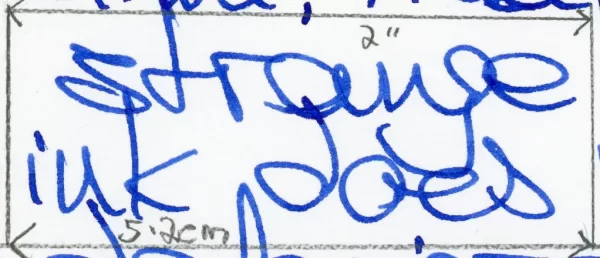
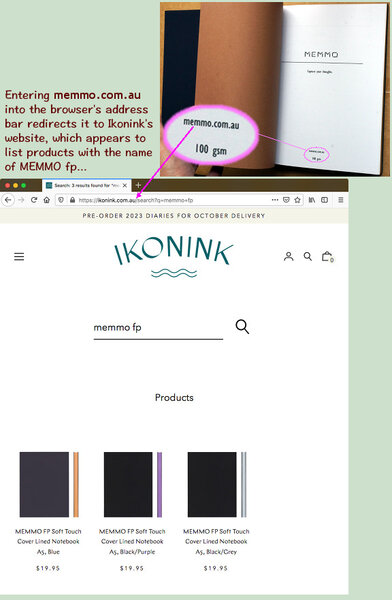
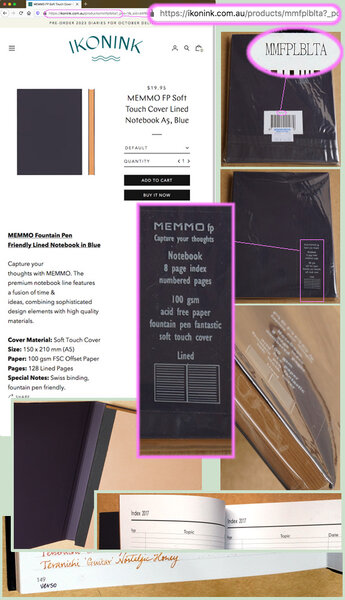

.jpg.ec078d243d364c44dbbf8c3fa3a07bf5.jpg)
.jpg.df8890b0f045a83b7c84a95381b30078.jpg)
.jpg.c77643978547cfe296c6c5dea7bf3994.jpg)
.jpg.06ad3cf4a7c1c3f1e50d855df021e103.jpg)
.jpg.3f661750bd9556a052eb80d343f0e169.jpg)
.jpg.389a7066c2186239ae2f75ac6d439665.jpg)
